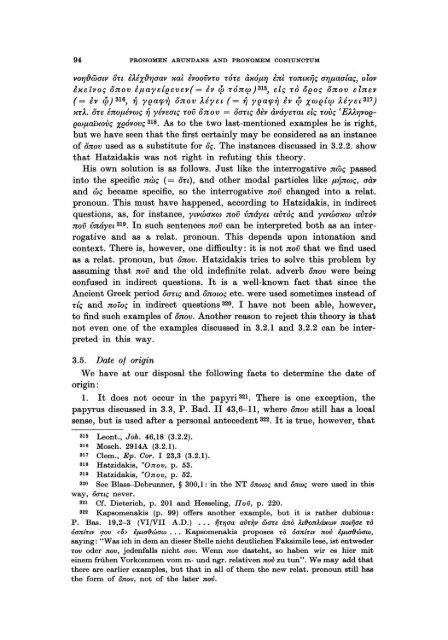Pronomen Abundans and Pronomen Coniunctum. A ... - DWC
Pronomen Abundans and Pronomen Coniunctum. A ... - DWC
Pronomen Abundans and Pronomen Coniunctum. A ... - DWC
You also want an ePaper? Increase the reach of your titles
YUMPU automatically turns print PDFs into web optimized ePapers that Google loves.
94 PRONOMEN ABUNDANS AND PRONOMEM CONIUNCTUM<br />
vorr{}W(Jtv on O..éx{}rwav xai lVOOVVTO Tóre àXó/1,'rj br:i Tomxijç a'Yjf-taa{aç, olov<br />
2 - J! ' , ('?,') 315 ' \" J!<br />
t::xetvoç u:n:ov ef-tayet(!evev = ev cp TO:n:cp ,etç TO O(!OÇ u:n:ov e l :n:ev<br />
(= lv cp) 316, ij y(!aq;ij o:n:ov Uyet (= ij y(!aq;ij lv cp Xw(!{cp Uyet 317 )<br />
X-rA.. ore é:n:of-tivwç ij yiveatç TOV o:n:ov = öanç (jèv àváye-rat elç TOVÇ 'E)')''Yjvo(!<br />
(!wf-taïxovç X(!ÓVOVÇ 318. As to the two last-mentioned examples he is right,<br />
but we have Been that the fust certainly may be considered as an instance<br />
of o:n:ov used as a substitute for oç. The instances discussed in 3.2.2. show<br />
that Hatzidakis was not right in refuting this theory.<br />
His own solution is as follows. Just like the interrogative :n:wç passed<br />
into the specific :n:wç (= on), <strong>and</strong> other modal particles like f-t~:n:wç, aàv<br />
<strong>and</strong> wç hecame specific, so the interrogative :n:OV changed into arelat.<br />
pronoun. This must have happened, according to Hatzidakis, in indirect<br />
questions, as, for instance, ytvwaxw :n:OV v:n:áyet aVToç <strong>and</strong> ywwaxw aVTov<br />
:n:OV v:n:áyet 319. In such sentences :n:OV can be interpreted both as an interrogative<br />
<strong>and</strong> as arelat. pronoun. This depends upon intonation <strong>and</strong><br />
context. There is, however, one difficulty: it is not :n:OV that we find used<br />
as a relat. pron~)Un, but Ö:n:ov. Hatzidakis tries to solve this problem by<br />
assuming that :n:OV <strong>and</strong> the old indefinite relat. adverb ö:n:ov were being<br />
confused in indirect questions. It is a well-known fact that since the<br />
Ancient Greek period öanç <strong>and</strong> o:n:owç etc. were used sometimes instead of<br />
T{Ç <strong>and</strong> :n:oioç in indirect questions 320. I have not been ahle, however,<br />
to find such examples of o:n:ov. Another reason to reject this theory is that<br />
not even one of the examples discussed in 3.2.1 <strong>and</strong> 3.2.2 can he interpreted<br />
in this way.<br />
3.5. Date ot origin<br />
We have at our disposal the following facts to determine the date of<br />
origin:<br />
1. It does not occur in the papyri 321. There is one exception, the<br />
papyrus discussed in 3.3, P . Bad. 11 43,6-11, where ö:n:ov still has alocal<br />
sense, but is used af ter a personal antecedent 322. It is true, however, that<br />
316 Leont., Joh. 46,18 (3 .2.2).<br />
316 Mosch. 2914A (3.2.1).<br />
317 Clem., Ep. Oor. I 23,3 (3.2.1).<br />
318 Hatzidakis, "Onov, p . 53.<br />
319 Hatzidakis, "Onov, p. 52.<br />
320 See Blass-Debrunner, § 300,1: in the NT önolOr; <strong>and</strong> önwr; were used in this<br />
way, ömLç never.<br />
321 Cf. Dieterich, p . 201 <strong>and</strong> Hesseling, IJ OV, p. 220.<br />
322 Kapsomenakis (p. 99) offers another example, but it is rather dubious:<br />
P. Bas. 19,2-3 (VlfVII A.D.) ... 1Tr1)aa avn)v rome dna Ä-LOonÄ-Wewv nOLijae Ta<br />
óaninv çrov ÈIJLaOwaw ... Kapsomenakis proposes Ta óaninv noV ÈIJLaOwaw,<br />
saying: "Was ich in dem an dieser Stelle nicht deutlichen Faksimile lese, ist entweder<br />
TOV oder nov, jedenfalls nicht aov. Wenn nov dasteht, so haben wir es hier mit<br />
einem frühen Vorkommen vom m· und ngr. relativen nov zu tun". We may add that<br />
there are earlier examples, but that in all of them the new relat. pronoun still has<br />
the form of önov, not of the later nov.
















